ACL Rehabilitation: Re-injury and Return to Sport Tests: Difference between revisions
No edit summary |
No edit summary |
||
| (48 intermediate revisions by 10 users not shown) | |||
| Line 2: | Line 2: | ||
<div class="editorbox"> | <div class="editorbox"> | ||
'''Original Editor '''- [[User:Mariam Hashem|Mariam Hashem]] | '''Original Editor '''- [[User:Mariam Hashem|Mariam Hashem]] | ||
'''Top Contributors''' - {{Special:Contributors/{{FULLPAGENAME}}}} | '''Top Contributors''' - {{Special:Contributors/{{FULLPAGENAME}}}} | ||
</div> | </div> | ||
== ACL Re-injury == | == ACL Re-injury == | ||
Despite advancement in surgical procedures, the | Despite the advancement in surgical procedures, the outcomes following [[ACL Reconstruction|ACL-reconstruction]] continue to be poor. Less than 50% of athletes are able to regain their pre-injury level of performance<ref>Dunn WR, Spindler KP, Moon Consortium. [https://europepmc.org/articles/pmc3745228 Predictors of Activity Level 2 Years After Anterior Cruciate Ligament Reconstruction (ACLR) A Multicenter Orthopaedic Outcomes Network (MOON) ACLR Cohort Study.] The American journal of sports medicine 2010;38(10):2040-50.</ref>. For those who returned successfully to sport, re-injury remains a risk factor. | ||
The incidence of re-injury in the first two years following reconstruction is estimated to be 6 times greater than those who didn't suffer ACL injury. This incidence is much higher in female athletes<ref name=":0">Paterno MV, Rauh MJ, Schmitt LC, Ford KR, Hewett TE. Incidence of second ACL injuries 2 years after primary ACL reconstruction and return to sport. The American journal of sports medicine | The incidence of re-injury in the first two years following reconstruction is estimated to be 6 times greater than those who didn't suffer ACL injury. This incidence is much higher in female athletes<ref name=":0">Paterno MV, Rauh MJ, Schmitt LC, Ford KR, Hewett TE. [https://journals.sagepub.com/doi/abs/10.1177/0363546514530088 Incidence of second ACL injuries 2 years after primary ACL reconstruction and return to sport.] The American journal of sports medicine 2014;42(7):1567-73.</ref>. A study reported 29.5% had re-injury within the first 24 months - 20.5% of injuries were contralateral (i.e. patients injured the former healthy knee) and 9% were ipsilateral (i..e. there was a re-rupture of the reconstruction)<ref name=":0" />. The risk of re-injury extends up to 5 years following injury<ref>Salmon L, Russell V, Musgrove T, Pinczewski L, Refshauge K. [https://www.researchgate.net/profile/Lucy_Salmon/publication/7676403_Incidence_and_Risk_Factors_for_Graft_Rupture_and_Contralateral_Rupture_After_Anterior_Cruciate_Ligament_Reconstruction/links/5b7c950a4585151fd126847c/Incidence-and-Risk-Factors-for-Graft Incidence and risk factors for graft rupture and contralateral rupture after anterior cruciate ligament reconstruction.] Arthroscopy: The Journal of Arthroscopic & Related Surgery 2005;21(8):948-57.</ref>. The grafted side has a lower chance of re-rupture if the individual passes return to play testing, but this doesn't appear to affect the contra-lateral side.<ref>Hurley ET, Mojica ES, Haskel JD, Mannino BJ, Alaia M, Strauss EJ, Jazrawi LM, Gonzlaez-Lomas G. [https://www.sciencedirect.com/science/article/abs/pii/S0968016021002751 Return to play testing following anterior cruciate reconstruction–A systematic review & meta-analysis.] The Knee. 2022 Jan 1;34:134-40.</ref> | ||
=== Re-injury Risk Factors === | === Re-injury Risk Factors === | ||
Risk factors of primary and second ACL | Risk factors of primary and second [https://www.physio-pedia.com/Anterior_Cruciate_Ligament_(ACL)_Injury ACL injuries] have been investigated widely in the literature. '''Biomechanical factors''' such as abnormal loading distribution patters around the [[knee]], increased external knee abduction moment in females<ref name=":3" />, side-to-side differences in lower extremities, frontal-plane displacement of the trunk<ref>Zazulak BT, Hewett TE, Reeves NP, Goldberg B, Cholewicki J. Deficits in neuromuscular control of the trunk predict knee injury risk: prospective biomechanical-epidemiologic study. The American journal of sports medicine. 2007;35(7):1123-30.</ref> and reduced lower extremity flexor activation in vertical jump<ref name=":3">Hewett TE1, Myer GD, Ford KR, Heidt RS Jr, Colosimo AJ, McLean SG, van den Bogert AJ, Paterno MV, Succop P. [https://engagedscholarship.csuohio.edu/cgi/viewcontent.cgi?article=1195&context=enme_facpub Biomechanical measures of neuromuscular control and valgus loading of the knee predict anterior cruciate ligament injury risk in female athletes: a prospective study.] The American journal of sports medicine 2005;33(4):492-501.</ref> have been associated with ACL injury. | ||
'''Deficits in Quadriceps weakness''' is a common persisting issue after surgery<ref name=":1">Hewett TE, Di Stasi SL, Myer GD. Current concepts for injury prevention in athletes after anterior cruciate ligament reconstruction. The American journal of sports medicine | '''Deficits in Quadriceps weakness''' is a common persisting issue after surgery<ref name=":1">Hewett TE, Di Stasi SL, Myer GD. [https://journals.sagepub.com/doi/abs/10.1177/0363546512459638 Current concepts for injury prevention in athletes after anterior cruciate ligament reconstruction.] The American journal of sports medicine 2013;41(1):216-24.</ref> which is manifested through abnormal loading patterns in gait and sports activities. A deficit of about 20% of quadriceps strength compared to the opposite side is found in athletes after ACL reconstruction. However, even a 90% quadriceps index is not necessarily associated with '''normal neuromuscular control.''' | ||
'''Asymmetry''' in the kinematics and differences in moment arm between involved side joints compared to the other side is another factor that continues to manifest years following surgery<ref>Castanharo R, Da Luz BS, Bitar AC, D’Elia CO, Castropil W, Duarte M. Males still have limb asymmetries in multijoint movement tasks more than 2 years following anterior cruciate ligament reconstruction. Journal of Orthopaedic Science | Four neuromuscular control deficits were considered to be risk factors for second ACL injury<ref name=":3" />: | ||
* [[Hip]] rotational control deficits | |||
* Excessive frontal-plane knee mechanics | |||
* Knee flexor deficits | |||
* [https://www.physio-pedia.com/The_Postural_Control_System Postural control] deficits | |||
'''Asymmetry''' in the kinematics and differences in moment arm between involved side joints compared to the other side is another factor that continues to manifest years following surgery<ref>Castanharo R, Da Luz BS, Bitar AC, D’Elia CO, Castropil W, Duarte M. [https://link.springer.com/article/10.1007/s00776-011-0118-3 Males still have limb asymmetries in multijoint movement tasks more than 2 years following anterior cruciate ligament reconstruction.] Journal of Orthopaedic Science 2011;16(5):531.</ref>. Asymmetry at the one-year follow-up of a difference in thigh circumference of more than 2.5 cm at was found a significant predictor of re-injury. <ref name=":9">Gupta R, Singhal A, Malhotra A, Soni A, Masih GD, Raghav M. [https://www.ncbi.nlm.nih.gov/pmc/articles/PMC7752004/ Predictors for Anterior Cruciate Ligament (ACL) Re-injury after Successful Primary ACL Reconstruction (ACLR)]. Malaysian Orthopaedic Journal. 2020 Nov;14(3):50.</ref> | |||
'''Abnormal movement patterns''' are often present bilaterally | '''Abnormal movement patterns''' are often present bilaterally, with changes in kinetics and kinematics showing in both knees. Studies report higher peak knee angles, moments, and joint powers relative to controls<ref name=":1" />. 3-dimensional biomechanical analyses and postural stability testing reported hip rotation moment changes during landing in the uninvolved side, frontal-plane knee motion during landing, sagittal plane knee moment asymmetries at initial contact, and deficits in postural stability on the reconstructed limb<ref name=":2" />. | ||
The development of '''compensatory strategies of the uninvolved hip''' is considered to be the primary predictor of risk in athletes who sustained a second ACL injury within the first year of return to play<ref name=":2">Paterno MV, Schmitt LC, Ford KR, Rauh MJ, Myer GD, Huang B, Hewett TE. Biomechanical measures during landing and postural stability predict second anterior cruciate ligament injury after anterior cruciate ligament reconstruction and return to sport. The American journal of sports medicine | The development of '''compensatory strategies of the uninvolved hip''' is considered to be the primary predictor of risk in athletes who sustained a second ACL injury within the first year of return to play<ref name=":2">Paterno MV, Schmitt LC, Ford KR, Rauh MJ, Myer GD, Huang B, Hewett TE. [https://journals.sagepub.com/doi/abs/10.1177/0363546510376053 Biomechanical measures during landing and postural stability predict second anterior cruciate ligament injury after anterior cruciate ligament reconstruction and return to sport.] The American journal of sports medicine 2010;38(10):1968-78.</ref>. Therefore, engaging both limbs in rehabilitation is a necessity<ref name=":1" />. | ||
''' | '''Gender''' may be a contributing factor to a secondary ACL injury. Graft rupture is more likely to occur in men, according to a 15-year cohort<ref>Leys T, Salmon L, Waller A, Linklater J, Pinczewski L. [https://journals.sagepub.com/doi/abs/10.1177/0363546511430375 Clinical results and risk factors for reinjury 15 years after anterior cruciate ligament reconstruction: a prospective study of hamstring and patellar tendon grafts.] The American journal of sports medicine 2012;40(3):595-605.</ref>. Another study reported no difference between sexes in graft rupture, however, the contralateral injury was higher in female athletes<ref>Shelbourne KD, Gray T, Haro M. [https://www.researchgate.net/profile/Marc_Haro/publication/23699613_Incidence_of_Subsequent_Injury_to_Either_Knee_Within_5_Years_After_Anterior_Cruciate_Ligament_Reconstruction_With_Patellar_Tendon_Autograft/links/55c0952e08aec0e5f4478e80.pdf Incidence of subsequent injury to either knee within 5 years after anterior cruciate ligament reconstruction with patellar tendon autograft.] The American journal of sports medicine 2009;37(2):246-51.</ref>. | ||
'''Young athletes''' are at a higher risk of re-injury and also to contralateral injury <ref name=":1" />. | '''Young athletes''' are at a higher risk of re-injury and also to contralateral injury <ref name=":1" />. | ||
'''Early return to sport''' in less than 9.5 months since surgery was shown to be a significant predictor of re-injury.<ref name=":9" /> | |||
=== Prevention of Re-injury === | === Prevention of Re-injury === | ||
Re-injury and the need to undergo a second ACL-reconstruction place the knee joint under devastating complications of developing OA, knee instability and difficulty in returning to sport. About 25% of athletes undergo a second revision within 6 years of the primary ACL revision<ref>Battaglia MJ, Cordasco FA, Hannafin JA, Rodeo SA, O'brien SJ, Altchek DW, Cavanaugh J, Wickiewicz TL, Warren RF. Results of revision anterior cruciate ligament surgery. The American journal of sports medicine | Re-injury and the need to undergo a second ACL-reconstruction place the knee joint under devastating complications of developing OA, knee instability and difficulty in returning to sport. About 25% of athletes undergo a second revision within 6 years of the primary ACL revision<ref>Battaglia MJ, Cordasco FA, Hannafin JA, Rodeo SA, O'brien SJ, Altchek DW, Cavanaugh J, Wickiewicz TL, Warren RF. [http://citeseerx.ist.psu.edu/viewdoc/download?doi=10.1.1.1004.7762&rep=rep1&type=pdf Results of revision anterior cruciate ligament surgery.] The American journal of sports medicine 2007;35(12):2057-66.</ref>. | ||
Understanding risk factors associated with re-injury is important to target all deficits in the rehabilitation program. | Understanding the risk factors associated with re-injury is important to target all deficits in the rehabilitation program. | ||
'''Side-to-side Quadriceps symmetry is essential to return to sport and prevention of future re-injury. Hamstrings/Quadriceps strength ratio''' is another important factor to be considered in rehabilitation. The aim is to achieve at least 85% strength symmetry before returning to sport<ref name=":1" />. | |||
Quadriceps symmetry is essential to return to sport and prevention of future re-injury. | |||
Single-leg plyometric tests can give the clinician an overview on how the injured limb is functioning and the differences between both sides. Findings in these tests should be considered when setting up the rehabilitation plan<ref name=":1" />. | Single-leg plyometric tests can give the clinician an overview on how the injured limb is functioning and the differences between both sides. Findings in these tests should be considered when setting up the rehabilitation plan<ref name=":1" />. | ||
A study reported 38.2% re-injuries in athletes who failed return to sport criteria suffered versus 5.6% of those who passed. The same study estimates 84% reduction of knee re-injury rates in patients who '''passes return to sport criteria'''<ref name=":7" />. | |||
'''Does timing play a role in preventing re-injury?''' | |||
A study reported a significant reduction by 51% for each month return to sport was delayed until 9 months after surgery, after which no further risk reduction was observed. <u>Delaying return to sport to 9 months</u> gives sufficient time to recondition the athlete and train them on all sport-specific drills necessary to avoid instability and future re-injury<ref name=":7">Grindem H, Snyder-Mackler L, Moksnes H, Engebretsen L, Risberg MA. [https://bjsm.bmj.com/content/50/13/804?hootPostID=c8e62d5240fc9ea4b548ed4e8ab496a2&utm_campaign=bjsm&utm_content=consumer&utm_medium=cpc&utm_source=trendmd&utm_term=1-A Simple decision rules can reduce reinjury risk by 84% after ACL reconstruction: the Delaware-Oslo ACL cohort study.] Br J Sports Med 2016;50(13):804-8. </ref> | |||
Another study advocates for the return to play for especially young athletes to be delayed for two years after ACL reconstruction. This is due to the increased incidence for a second ACL injury within two years after surgery and the fact that the biological health and function of the knee joint is closer to baseline around two years. <ref>Nagelli CV, Hewett TE. [https://www.ncbi.nlm.nih.gov/pmc/articles/PMC5226931/ Should return to sport be delayed until 2 years after anterior cruciate ligament reconstruction?] Biological and functional considerations. Sports Medicine. 2017 Feb;47(2):221-32.</ref> | |||
'''The Influence of Psychological factors''' | |||
Pain-related fear plays a key role in distinguishing athletes who may not be able to return to pre-injury levels. Lack of confidence and fear of re-injury are believed to influence function<ref>Liew BX, Feller JA, Webster KE. [https://journals.plos.org/plosone/article?id=10.1371/journal.pone.0266029 Understanding the psychological mechanisms of return to sports readiness after anterior cruciate ligament reconstruction.] PLoS One. 2022 Mar 24;17(3):e0266029.</ref>. For these reasons, the assessment of these factors must be included in the management plan<ref>Lentz TA, Zeppieri Jr G, George SZ, Tillman SM, Moser MW, Farmer KW, Chmielewski TL. [https://www.researchgate.net/profile/Giorgio_Zeppieri/publication/269224033_Comparison_of_Physical_Impairment_Functional_and_Psychosocial_Measures_Based_on_Fear_of_ReinjuryLack_of_Confidence_and_Return-to-Sport_Status_After_ACL_Reconstruction/links/5628f9 Comparison of physical impairment, functional, and psychosocial measures based on fear of reinjury/lack of confidence and return-to-sport status after ACL reconstruction.] The American journal of sports medicine 2015;43(2):345-53.</ref>. | |||
[[Fear Avoidance Model|The fear-avoidance model]], self-efficacy theory, stress, social support, and athletic self-identity explain the inability to return to sport in athletes with a full level of function and are predictive of outcomes after surgery<ref>Everhart JS, Best TM, Flanigan DC. [https://www.researchgate.net/profile/Joshua_Everhart/publication/257814103_Psychological_predictors_of_anterior_cruciate_ligament_reconstruction_outcomes_a_systematic_review/links/0a85e53b428d5eb7ac000000.pdf Psychological predictors of anterior cruciate ligament reconstruction outcomes: a systematic review.] Knee Surgery, Sports Traumatology, Arthroscopy 2015;23(3):752-62.</ref>. | |||
Motivation also plays a role when engaging an athlete into the rehabilitation plan (45% of community-level athletes discontinuing supervised rehabilitation by 3 months post ACL-reconstruction<ref name=":7" />) and also to go through all stages of return to sport rehab. An athlete may feel ready and competitive before passing all stages and may discourage rehabilitation before regaining all required criteria to return to sport. Quality [[Patient education in Pain Management|patient education]], goal setting, frequent feedback and individualization of the rehabilitation plan are all recommended to stimulate motivation<ref>Culvenor AG, Barton CJ. [https://bjsm.bmj.com/content/52/22/1416.abstract ACL injuries: the secret probably lies in optimising rehabilitation.] Br J Sports Med 2018;52(22):1416-1418.</ref>. | |||
=== Predicting Functional Outcomes after Surgery === | |||
Factors such as age, gender, body mass index (BMI), smoking, concomitant injuries, and physical impairments before and after surgery have an influence on the expected outcomes after surgery. However, they don't explain variance in knee function after ACL reconstruction and rehabilitation. Recently it has been shown that there is a strong correlation between early stage quadricep strength and late stage quadricep strength. The earlier the strength is restored, the better the patient performs at a later stage.<ref name=":10">Ebert JR, Edwards P, Du Preez L, Furzer B, Joss B. [https://www.sciencedirect.com/science/article/abs/pii/S0968016021001265 Knee extensor strength, hop performance, patient-reported outcome and inter-test correlation in patients 9–12 months after anterior cruciate ligament reconstruction.] The Knee. 2021 Jun 1;30:176-84.</ref><ref>Hannon JP, Wang-Price S, Goto S, Singleton S, Dietrich L, Bothwell J, Bush C, Garrison C. [https://www.ncbi.nlm.nih.gov/pmc/articles/PMC8169016/ Twelve-week quadriceps strength as a predictor of quadriceps strength at time of return to sport testing following bone-patellar tendon-bone autograft anterior cruciate ligament reconstruction.] International Journal of Sports Physical Therapy. 2021;16(3):681.</ref> | |||
Logerstedt et al.<ref name=":5" /> reported that single-leg hop tests performed 6 months after ACL reconstruction can predict the likelihood of a successful or unsuccessful outcome 1 year after ACL reconstruction. Of the 4 hop tests, the 6-m Timed Hop and the Crossover Hop were the best predictors. The 6-m Timed Hop challenges neuromuscular control of the knee, thereby highlighting asymmetries. Performing these tests 6 months after surgery before resuming sport-specific training allows sufficient time to address deficits that may contribute to re-injury. | |||
The following factors, if present, can predict a return to pre-injury status<ref name=":6">Lentz TA, Zeppieri Jr G, Tillman SM, Indelicato PA, Moser MW, George SZ, Chmielewski TL. [https://www.jospt.org/doi/pdfplus/10.2519/jospt.2012.4077 Return to preinjury sports participation following anterior cruciate ligament reconstruction: contributions of demographic, knee impairment, and self-report measures.] Journal of orthopaedic & sports physical therapy 2012;42(11):893-901.</ref>: | |||
* Less knee effusion | |||
* Fewer episodes of the knee giving way | |||
* Lower knee pain intensity | |||
* Higher quadriceps peak torque-body weight ratio | |||
* Higher score on the International Knee Documentation Committee Subjective Knee Evaluation Form | |||
* Lower levels of kinesiophobia | |||
== Return to Sport == | == Return to Sport == | ||
With the high incidence of re-injury and the evidence of poor outcomes of ACL-reconstruction revision, a need for a return to sport protocol has developed. | With the high incidence of re-injury and the evidence of poor outcomes of ACL-reconstruction revision, a need for a return to sport protocol has developed. | ||
Myer et al <ref name=":4">Myer GD, Paterno MV, Ford KR, Hewett TE. Neuromuscular training techniques to target deficits before return to sport after anterior cruciate ligament reconstruction. The Journal of Strength & Conditioning Research | Myer et al<ref name=":4">Myer GD, Paterno MV, Ford KR, Hewett TE. [https://pdfs.semanticscholar.org/bc8a/426952045acb3b033ba26b7d50f57ac14e12.pdf Neuromuscular training techniques to target deficits before return to sport after anterior cruciate ligament reconstruction.] The Journal of Strength & Conditioning Research 2008;22(3):987-1014.</ref> proposed '''four stages of advanced rehabilitation protocol''' to address common deficits found in athletes after ACL-reconstruction: | ||
'''Stage 1:''' Dynamic stabilization and core strengthening | '''Stage 1:''' Dynamic stabilization and core strengthening | ||
| Line 51: | Line 78: | ||
'''Stage 2''': Functional strengthening | '''Stage 2''': Functional strengthening | ||
'''Stage 3''':Power development | '''Stage 3''': Power development | ||
'''Stage 4''': Sports performance symmetry. | '''Stage 4''': Sports performance symmetry. | ||
The aim of this protocol is to recondition athletes to function optimally by targeting | The aim of this protocol is to recondition athletes to function optimally by targeting neuromuscular deficits to minimize rates of re-injury. | ||
Monitoring signs of overload in all stages is critical to prevent adverse effects<ref name=":4" />. | Monitoring signs of overload in all stages is critical to prevent adverse effects<ref name=":4" />. | ||
=== Stage I :Dynamic Stabilization and CORE Strengthening === | === Stage I: Dynamic Stabilization and CORE Strengthening === | ||
'''Goals of this stage:''' | '''Goals of this stage:''' | ||
* Improving single-limb weight-bearing function to tolerate greater knee flexion angles. | |||
* Improving lower extremity symmetry | |||
* Enhancement of closed chain single-limb postural balance. | |||
A strong CORE will allow the athlete to control the deceleration of the centre of mass with a balanced posture and accelerate their mass rapidly by controlled force. Weakness and deficits in the trunk and hip musculature are correlated with biomechanical abnormalities and ACL injuries, particularly in female athletes<ref name=":3" /><ref>Padua DA, Marshall SW, Beutler AI, DeMaio M, Boden BP, Yu B, Garrett WE. [https://www.researchgate.net/publication/275355236_Kinematics_and_Kinetics_Predictor_of_Proximal_Tibia_Anterior_Shear_Force_during_Single_Leg_Drop_Landing Predictors of knee valgus angle during a jump-landing task]. Medicine & Science in Sports & Exercise 2005;37(5):S398.</ref>. | |||
A strong CORE will allow the athlete to control the deceleration of the | |||
Prior to CORE strengthening training, balance, proprioception and gait deviations should be well-addressed. | Prior to CORE strengthening training, balance, proprioception and gait deviations should be well-addressed. | ||
It is important to note that an athlete may have full anatomical ROM but with functional activities, asymmetries and deficits may be present<ref name=":4" />. Addressing these deficits will allow progression in speed and intensity of running without pain and re-injury. Deficits in rhythmic strides and symmetry can be detected by audible monitoring of foot contact. Pain, particularly patellofemoral pain, or ROM deficits are contributing factors to unbalanced sprinting gait. Backward gait is a way of decreasing patellofemoral pain and help the athlete to progress in this stage and may also increase quad strength<ref name=":4" />. | It is important to note that an athlete may have full anatomical [https://www.physio-pedia.com/Range_of_Motion ROM] but with functional activities, asymmetries and deficits may be present<ref name=":4" />. Addressing these deficits will allow progression in speed and intensity of running without pain and re-injury. Deficits in rhythmic strides and symmetry can be detected by audible monitoring of foot contact. Pain, particularly patellofemoral pain, or ROM deficits are contributing factors to unbalanced sprinting gait. Backward gait is a way of decreasing patellofemoral pain and help the athlete to progress in this stage and may also increase quad strength<ref name=":4" />. | ||
Examples of exercises to be used in this stage: | Examples of exercises to be used in this stage: | ||
{| class="wikitable" width="100%" cellspacing="6" cellpadding="0" border="0" | {| class="wikitable" width="100%" cellspacing="6" cellpadding="0" border="0" | ||
|- | |- | ||
| [[File:Single leg dead lift.jpg]] | | [[File:Single leg dead lift.jpg|300x300px]] | ||
| [[File:Bilateral knee balance on BOSU.jpg]] | | [[File:Bilateral knee balance on BOSU.jpg|311x311px]] | ||
|- | |- | ||
| [[File:Bridge on BOSU.jpg]] | | [[File:Bridge on BOSU.jpg|300x300px]] | ||
| [[File:Wall squat with stability ball.jpg]] | | [[File:Wall squat with stability ball.jpg|311x311px]] | ||
|} | |} | ||
Exercise intensity should be changed constantly to challenge | Each athlete will need individualized variations according to individual characteristics and sport. | ||
Exercise intensity should be changed constantly to challenge [[balance]] and [[proprioception]]. Modifications of body posture, switching between various unstable surfaces, speed modifications, adding a sport-specific skill and/or adding unanticipated movement can all be ways of challenging stability and balance. | |||
The following recommendations are made in the Evidence-based clinical practice update<ref>van Melick N, van Cingel RE, Brooijmans F, Neeter C, van Tienen T, Hullegie W, Nijhuis-van der Sanden MW. [https://core.ac.uk/download/pdf/200780451.pdf#page=30 Evidence-based clinical practice update: practice guidelines for anterior cruciate ligament rehabilitation based on a systematic review and multidisciplinary consensus]. British journal of sports medicine. 2016 Dec 1;50(24):1506-15.</ref> | |||
* Isometric quadriceps exercises are deemed safe from the first week after ACL reconstruction | |||
* Eccentric quadriceps strengthening in a closed kinematic chain 3 weeks of ACL reconstruction is deemed safe and will lead to a greater improvement in quadriceps strength when compared to concentric strengthening | |||
* It is important to add neuromuscular training to strength training as it improves the self-reported outcome measurements | |||
=== Stage II: Functional strengthening === | === Stage II: Functional strengthening === | ||
'''Goals of this stage:''' | '''Goals of this stage:''' | ||
* Increasing lower extremity non weight-bearing strength. | * Increasing lower extremity non-weight-bearing strength. | ||
* Improving load distribution pattern over both lower extremities in activities requiring double-leg stance. | * Improving load distribution pattern over both lower extremities in activities requiring double-leg stance. | ||
* Improvement of single-limb landing force attenuation strategies. | * Improvement of single-limb landing force attenuation strategies. | ||
With CORE strengthening and dynamic stabilization exercises continuing throughout this stage, progressive lower extremity strengthening is introduced. Gradually and frequently adding more resistance without compromising good form. | With CORE strengthening and dynamic stabilization exercises continuing throughout this stage, progressive lower extremity strengthening is introduced. Gradually and frequently adding more resistance without compromising good form. | ||
Retrograde training, for example | Retrograde training, for example backwards running on a treadmill or backward jumping, has been shown to increase functional quadriceps activation and to limit [[Patellofemoral Joint|patellofemoral]] pain<ref>Flynn TW, Soutas-Little RW. [https://www.jospt.org/doi/pdf/10.2519/jospt.1993.17.2.108 Mechanical power and muscle action during forward and backward running.] Journal of Orthopaedic & Sports Physical Therapy 1993;17(2):108-12.</ref><ref>Flynn TW, Soutas-Little RW. [https://www.jospt.org/doi/pdf/10.2519/jospt.1995.21.5.277 Patellofemoral joint compressive forces in forward and backward running.] Journal of Orthopaedic & Sports Physical Therapy 1995;21(5):277-82.</ref> | ||
Examples of exercises to be used in this stage: | Examples of exercises to be used in this stage: | ||
{| class="wikitable" width="100%" cellspacing="6" cellpadding="0" border="0" | {| class="wikitable" width="100%" cellspacing="6" cellpadding="0" border="0" | ||
|- | |- | ||
| [[File:Lateral step down BOSU.jpg]] | | [[File:Lateral step down BOSU.jpg|480x480px]] | ||
| [[File:Single leg squat BOSU.gif]] | | [[File:Single leg squat BOSU.gif|341x341px]] | ||
|- | |- | ||
| [[File:Table-top crunches.gif]] | | [[File:Table-top crunches.gif]] | ||
| [[File:Single | | [[File:Single Leg Bridge on Ball.png]] | ||
|- | |- | ||
| [[File:Hamstrings curl on swiss ball.gif]] | | [[File:Hamstrings curl on swiss ball.gif|300x300px]] | ||
| [[File:Lateral lunges.gif]] | | [[File:Lateral lunges.gif|317x317px]] | ||
|} | |} | ||
=== Stage III: Power development === | === Stage III: Power development === | ||
At this stage, power production of lower extremity is the main aim. Additionally, athletes are trained to resist fatigue and perform | At this stage, power production of the lower extremity is the main aim. Additionally, athletes are trained to resist fatigue and perform plyometrics with good biomechanics<ref name=":4" />. Training incorporates mid-level intensity double-limb multi-planar plyometric jumps and low-intensity single-limb hops. | ||
Provide feedback and educate the athlete to land softly with coronal plane knee control. | Provide feedback and educate the athlete to land softly with coronal plane knee control. | ||
Combining plyometrics with strength training improved jump performance and leg strength<ref>Fatouros IG, Jamurtas AZ, Leontsini D, Taxildaris K, Aggelousis N, Kostopoulos N, Buckenmeyer P. Evaluation of plyometric exercise training, weight training, and their combination on vertical jumping performance and leg strength. The Journal of Strength & Conditioning Research | Combining plyometrics with strength training improved jump performance and leg strength<ref>Fatouros IG, Jamurtas AZ, Leontsini D, Taxildaris K, Aggelousis N, Kostopoulos N, Buckenmeyer P. [https://www.researchgate.net/profile/Ioannis_Fatouros/publication/232206205_Evaluation_of_Plyometric_Exercise_Training_Weight_Training_and_Their_Combination_on_Vertical_Jumping_Performance_and_Leg_Strength/links/5813cdb708aedc7d8961e7ff/Evaluation-of-Plyo Evaluation of plyometric exercise training, weight training, and their combination on vertical jumping performance and leg strength.] The Journal of Strength & Conditioning Research 2000;14(4):470-6.</ref>. The addition of neuromuscular training with plyometrics, CORE and speed training resulted in great outcomes in performance measures<ref name=":4" />. | ||
Examples of exercises to be used in this stage: | Examples of exercises to be used in this stage: | ||
{| class="wikitable" width="100%" cellspacing="6" cellpadding="0" border="0" | |||
|- | |||
| [[File:Single leg X hop.jpg|311x311px]] | |||
| [[File:Barbell back squat.gif|301x301px]] | |||
|- | |||
| [[File:Nordic hamstring curls.gif|391x391px]] | |||
| [[File:Lateral crunches.jpg|311x311px]] | |||
|- | |||
| [[File:Jump Forward and Back.png]] | |||
| [[File:Back extensio on swiss ball.jpg|300x300px]] | |||
|} | |||
=== Stage IV: Sport Performance Symmetry === | === Stage IV: Sport Performance Symmetry === | ||
At this stage athletes are trained to utilize safe biomechanics (increased knee flexion and decreased knee abduction angles with symmetrical forces and motions between limbs) in high-intensity plyometric exercises, produce symmetrical power between both lower extremities and learn to improve confidence to maintain dynamic knee stability with high-intensity change of direction activities<ref name=":4" />. | At this stage, athletes are trained to utilize safe biomechanics (increased knee flexion and decreased knee abduction angles with symmetrical forces and motions between limbs) in high-intensity plyometric exercises, produce symmetrical power between both lower extremities and learn to improve confidence to maintain dynamic knee stability with high-intensity change of direction activities<ref name=":4" />. | ||
Verbal and visual feedback are important at this stage. | Verbal and visual feedback are important at this stage. | ||
Increased valgus angle is a factor contributing to injuries, particularly in | Increased valgus angle is a factor contributing to injuries, particularly in females. Valgus loads on the knee can double during unanticipated cutting manoeuvres. By teaching athletes to use movement techniques that produce low knee abduction moments during movements that can produce high loads on the joint, they can ultimately reduce the risk of injury<ref name=":4" />. | ||
Examples of exercises to be used in this stage: | Examples of exercises to be used in this stage: | ||
{| class="wikitable" width="100%" cellspacing="6" cellpadding="0" border="0" | |||
|- | |||
| [[File:Lunge jump.jpg]] | |||
| {{#ev:youtube|zh1v8jINBZ0}}<ref>Tuck Jump. Available from: https://www.youtube.com/watch?v=zh1v8jINBZ0</ref> | |||
|- | |||
| {{#ev:youtube|KDwzB6xuZ9o}}<ref>TFW Explosive Box Step Up. Available from:https://www.youtube.com/watch?v=KDwzB6xuZ9o </ref> | |||
| {{#ev:youtube|5EztcmA0Amc}}<ref>Depth jump to box jump - Increase vertical jump - Volleyball. Available from: https://www.youtube.com/watch?v=5EztcmA0Amc</ref> | |||
|- | |||
| {{#ev:youtube|HwPCpzLmSYQ}}<ref>Four Corner Drill. Available from: https://www.youtube.com/watch?v=HwPCpzLmSYQ</ref> | |||
| {{#ev:youtube|hXNuP6ohxwQ}}<ref>SPEED TRAINING: Quick Cut "W" Drill. Available from: https://www.youtube.com/watch?v=hXNuP6ohxwQ</ref> | |||
|} | |||
=== | == Return to Sport Criteria == | ||
Evidence of deficits in muscular strength and balance exist months after surgery in both ACL-reconstructed knee and contralateral limb<ref name=":8">Barber-Westin SD, Noyes FR. [https://www.arthroscopyjournal.org/article/S0749-8063(11)01125-X/fulltext Factors used to determine return to unrestricted sports activities after anterior cruciate ligament reconstruction.] Arthroscopy: The Journal of Arthroscopic & Related Surgery 2011;27(12):1697-705.</ref>. Abnormal knee kinematics was found up to a year following surgery<ref>Deneweth JM, Bey MJ, McLean SG, Lock TR, Kolowich PA, Tashman S. [https://journals.sagepub.com/doi/abs/10.1177/0363546510365531 Tibiofemoral joint kinematics of the anterior cruciate ligament-reconstructed knee during a single-legged hop landing.] The American journal of sports medicine 2010;38(9):1820-8.</ref>. | |||
= | A systematic review by Barber-Westin and colleagues<ref name=":8" /> investigated return to sport criteria in many studies and concluded that in order to give clearance to return to sport an athlete must have: | ||
* Less than 10% deficit in strength of the quadriceps and hamstring on isokinetic testing at 180°/s and 300°/s, | |||
* Less than 15% deficit in lower limb symmetry on [[Hop Test|single-leg hop testing]] (single hop, triple hop, crossover hop, and timed hop)<ref name=":10" /> | |||
* Less than 3 mm of increased anterior-posterior tibial displacement on [[Lachman Test|Lachman]] or knee arthrometer testing, | |||
* Greater than 60% normalized knee separation distance on a video drop-jump test, | |||
* Absence of effusion | |||
* Full knee ROM | |||
* Normal patellar mobility, | |||
* No or only slight patellar crepitus, | |||
* Painless activities without swelling. | |||
== | {| class="wikitable" width="100%" cellspacing="6" cellpadding="0" border="0" | ||
|- | |||
| {{#ev:youtube|5DrD-G4gWt8}}<ref>ACL Prevention Screening: The Drop Jump Test. Available from:https://www.youtube.com/watch?v=5DrD-G4gWt8 </ref> | |||
| {{#ev:youtube|4Rp_BJUBQ6g}}<ref>Triple hop for distance. Available from: https://www.youtube.com/watch?v=4Rp_BJUBQ6g</ref> | |||
|} | |||
The International Knee Documentation Committee is a great tool to assess knee function and differentiate high knee function from low knee function<ref name=":5">Logerstedt D, Grindem H, Lynch A, Eitzen I, Engebretsen L, Risberg MA, Axe MJ, Snyder-Mackler L. [https://journals.sagepub.com/doi/abs/10.1177/0363546512457551 Single-legged hop tests as predictors of self-reported knee function after anterior cruciate ligament reconstruction: the Delaware-Oslo ACL cohort study.] The American journal of sports medicine 2012;40(10):2348-56.</ref>. | |||
Single-legged hop tests assess different measures such as performance, strength, neuromuscular control, confidence in the limb, and the ability to tolerate loads related to sports-specific activities. Specific deficits can be detected in these tests, allowing the clinician to tackle them in the rehabilitation plan and also give an idea on time to return to sport<ref name=":5" />. | |||
Single-legged hop tests | |||
== References == | == References == | ||
<references /> | <references /> | ||
[[Category:Knee]] | |||
[[Category:Conditions]] | |||
[[Category:Knee - Conditions]] | |||
[[Category:Assessment]] | |||
[[Category:Knee - Assessment and Examination]] | |||
[[Category:Interventions]] | |||
[[Category:Knee - Interventions]] | |||
[[Category:Knee Injuries]] | |||
[[ Category:Sports Injuries]] | |||
[[Category:Musculoskeletal/Orthopaedics]] | |||
[[Category:Sports Medicine]] | |||
[[Category:Sports Injuries]] | |||
[[Category:Course Pages]] | |||
[[Category:Plus Content]] | |||
Latest revision as of 01:28, 11 December 2023
Original Editor - Mariam Hashem Top Contributors - Mariam Hashem, Kim Jackson, Tarina van der Stockt, Uchechukwu Chukwuemeka, Rucha Gadgil, Chelsea Mclene, Leana Louw, Wanda van Niekerk, Jess Bell, Olajumoke Ogunleye and Carin Hunter
ACL Re-injury[edit | edit source]
Despite the advancement in surgical procedures, the outcomes following ACL-reconstruction continue to be poor. Less than 50% of athletes are able to regain their pre-injury level of performance[1]. For those who returned successfully to sport, re-injury remains a risk factor.
The incidence of re-injury in the first two years following reconstruction is estimated to be 6 times greater than those who didn't suffer ACL injury. This incidence is much higher in female athletes[2]. A study reported 29.5% had re-injury within the first 24 months - 20.5% of injuries were contralateral (i.e. patients injured the former healthy knee) and 9% were ipsilateral (i..e. there was a re-rupture of the reconstruction)[2]. The risk of re-injury extends up to 5 years following injury[3]. The grafted side has a lower chance of re-rupture if the individual passes return to play testing, but this doesn't appear to affect the contra-lateral side.[4]
Re-injury Risk Factors[edit | edit source]
Risk factors of primary and second ACL injuries have been investigated widely in the literature. Biomechanical factors such as abnormal loading distribution patters around the knee, increased external knee abduction moment in females[5], side-to-side differences in lower extremities, frontal-plane displacement of the trunk[6] and reduced lower extremity flexor activation in vertical jump[5] have been associated with ACL injury.
Deficits in Quadriceps weakness is a common persisting issue after surgery[7] which is manifested through abnormal loading patterns in gait and sports activities. A deficit of about 20% of quadriceps strength compared to the opposite side is found in athletes after ACL reconstruction. However, even a 90% quadriceps index is not necessarily associated with normal neuromuscular control.
Four neuromuscular control deficits were considered to be risk factors for second ACL injury[5]:
- Hip rotational control deficits
- Excessive frontal-plane knee mechanics
- Knee flexor deficits
- Postural control deficits
Asymmetry in the kinematics and differences in moment arm between involved side joints compared to the other side is another factor that continues to manifest years following surgery[8]. Asymmetry at the one-year follow-up of a difference in thigh circumference of more than 2.5 cm at was found a significant predictor of re-injury. [9]
Abnormal movement patterns are often present bilaterally, with changes in kinetics and kinematics showing in both knees. Studies report higher peak knee angles, moments, and joint powers relative to controls[7]. 3-dimensional biomechanical analyses and postural stability testing reported hip rotation moment changes during landing in the uninvolved side, frontal-plane knee motion during landing, sagittal plane knee moment asymmetries at initial contact, and deficits in postural stability on the reconstructed limb[10].
The development of compensatory strategies of the uninvolved hip is considered to be the primary predictor of risk in athletes who sustained a second ACL injury within the first year of return to play[10]. Therefore, engaging both limbs in rehabilitation is a necessity[7].
Gender may be a contributing factor to a secondary ACL injury. Graft rupture is more likely to occur in men, according to a 15-year cohort[11]. Another study reported no difference between sexes in graft rupture, however, the contralateral injury was higher in female athletes[12].
Young athletes are at a higher risk of re-injury and also to contralateral injury [7].
Early return to sport in less than 9.5 months since surgery was shown to be a significant predictor of re-injury.[9]
Prevention of Re-injury[edit | edit source]
Re-injury and the need to undergo a second ACL-reconstruction place the knee joint under devastating complications of developing OA, knee instability and difficulty in returning to sport. About 25% of athletes undergo a second revision within 6 years of the primary ACL revision[13].
Understanding the risk factors associated with re-injury is important to target all deficits in the rehabilitation program.
Side-to-side Quadriceps symmetry is essential to return to sport and prevention of future re-injury. Hamstrings/Quadriceps strength ratio is another important factor to be considered in rehabilitation. The aim is to achieve at least 85% strength symmetry before returning to sport[7].
Single-leg plyometric tests can give the clinician an overview on how the injured limb is functioning and the differences between both sides. Findings in these tests should be considered when setting up the rehabilitation plan[7].
A study reported 38.2% re-injuries in athletes who failed return to sport criteria suffered versus 5.6% of those who passed. The same study estimates 84% reduction of knee re-injury rates in patients who passes return to sport criteria[14].
Does timing play a role in preventing re-injury?
A study reported a significant reduction by 51% for each month return to sport was delayed until 9 months after surgery, after which no further risk reduction was observed. Delaying return to sport to 9 months gives sufficient time to recondition the athlete and train them on all sport-specific drills necessary to avoid instability and future re-injury[14]
Another study advocates for the return to play for especially young athletes to be delayed for two years after ACL reconstruction. This is due to the increased incidence for a second ACL injury within two years after surgery and the fact that the biological health and function of the knee joint is closer to baseline around two years. [15]
The Influence of Psychological factors
Pain-related fear plays a key role in distinguishing athletes who may not be able to return to pre-injury levels. Lack of confidence and fear of re-injury are believed to influence function[16]. For these reasons, the assessment of these factors must be included in the management plan[17].
The fear-avoidance model, self-efficacy theory, stress, social support, and athletic self-identity explain the inability to return to sport in athletes with a full level of function and are predictive of outcomes after surgery[18].
Motivation also plays a role when engaging an athlete into the rehabilitation plan (45% of community-level athletes discontinuing supervised rehabilitation by 3 months post ACL-reconstruction[14]) and also to go through all stages of return to sport rehab. An athlete may feel ready and competitive before passing all stages and may discourage rehabilitation before regaining all required criteria to return to sport. Quality patient education, goal setting, frequent feedback and individualization of the rehabilitation plan are all recommended to stimulate motivation[19].
Predicting Functional Outcomes after Surgery[edit | edit source]
Factors such as age, gender, body mass index (BMI), smoking, concomitant injuries, and physical impairments before and after surgery have an influence on the expected outcomes after surgery. However, they don't explain variance in knee function after ACL reconstruction and rehabilitation. Recently it has been shown that there is a strong correlation between early stage quadricep strength and late stage quadricep strength. The earlier the strength is restored, the better the patient performs at a later stage.[20][21]
Logerstedt et al.[22] reported that single-leg hop tests performed 6 months after ACL reconstruction can predict the likelihood of a successful or unsuccessful outcome 1 year after ACL reconstruction. Of the 4 hop tests, the 6-m Timed Hop and the Crossover Hop were the best predictors. The 6-m Timed Hop challenges neuromuscular control of the knee, thereby highlighting asymmetries. Performing these tests 6 months after surgery before resuming sport-specific training allows sufficient time to address deficits that may contribute to re-injury.
The following factors, if present, can predict a return to pre-injury status[23]:
- Less knee effusion
- Fewer episodes of the knee giving way
- Lower knee pain intensity
- Higher quadriceps peak torque-body weight ratio
- Higher score on the International Knee Documentation Committee Subjective Knee Evaluation Form
- Lower levels of kinesiophobia
Return to Sport[edit | edit source]
With the high incidence of re-injury and the evidence of poor outcomes of ACL-reconstruction revision, a need for a return to sport protocol has developed.
Myer et al[24] proposed four stages of advanced rehabilitation protocol to address common deficits found in athletes after ACL-reconstruction:
Stage 1: Dynamic stabilization and core strengthening
Stage 2: Functional strengthening
Stage 3: Power development
Stage 4: Sports performance symmetry.
The aim of this protocol is to recondition athletes to function optimally by targeting neuromuscular deficits to minimize rates of re-injury.
Monitoring signs of overload in all stages is critical to prevent adverse effects[24].
Stage I: Dynamic Stabilization and CORE Strengthening[edit | edit source]
Goals of this stage:
- Improving single-limb weight-bearing function to tolerate greater knee flexion angles.
- Improving lower extremity symmetry
- Enhancement of closed chain single-limb postural balance.
A strong CORE will allow the athlete to control the deceleration of the centre of mass with a balanced posture and accelerate their mass rapidly by controlled force. Weakness and deficits in the trunk and hip musculature are correlated with biomechanical abnormalities and ACL injuries, particularly in female athletes[5][25].
Prior to CORE strengthening training, balance, proprioception and gait deviations should be well-addressed.
It is important to note that an athlete may have full anatomical ROM but with functional activities, asymmetries and deficits may be present[24]. Addressing these deficits will allow progression in speed and intensity of running without pain and re-injury. Deficits in rhythmic strides and symmetry can be detected by audible monitoring of foot contact. Pain, particularly patellofemoral pain, or ROM deficits are contributing factors to unbalanced sprinting gait. Backward gait is a way of decreasing patellofemoral pain and help the athlete to progress in this stage and may also increase quad strength[24].
Examples of exercises to be used in this stage:
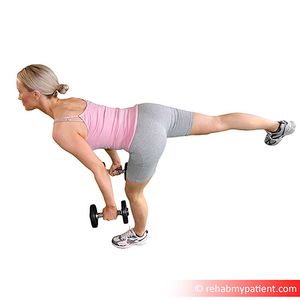
|
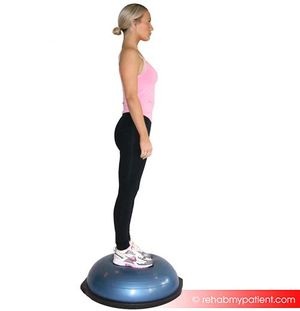
|
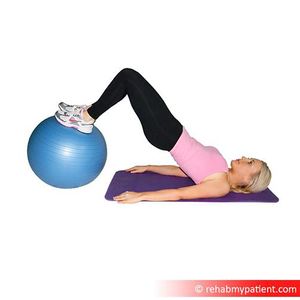
|
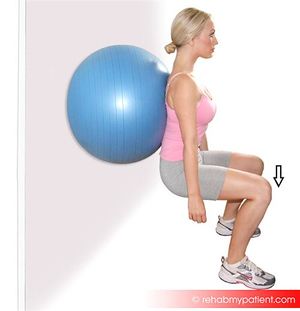
|
Each athlete will need individualized variations according to individual characteristics and sport.
Exercise intensity should be changed constantly to challenge balance and proprioception. Modifications of body posture, switching between various unstable surfaces, speed modifications, adding a sport-specific skill and/or adding unanticipated movement can all be ways of challenging stability and balance.
The following recommendations are made in the Evidence-based clinical practice update[26]
- Isometric quadriceps exercises are deemed safe from the first week after ACL reconstruction
- Eccentric quadriceps strengthening in a closed kinematic chain 3 weeks of ACL reconstruction is deemed safe and will lead to a greater improvement in quadriceps strength when compared to concentric strengthening
- It is important to add neuromuscular training to strength training as it improves the self-reported outcome measurements
Stage II: Functional strengthening[edit | edit source]
Goals of this stage:
- Increasing lower extremity non-weight-bearing strength.
- Improving load distribution pattern over both lower extremities in activities requiring double-leg stance.
- Improvement of single-limb landing force attenuation strategies.
With CORE strengthening and dynamic stabilization exercises continuing throughout this stage, progressive lower extremity strengthening is introduced. Gradually and frequently adding more resistance without compromising good form.
Retrograde training, for example backwards running on a treadmill or backward jumping, has been shown to increase functional quadriceps activation and to limit patellofemoral pain[27][28]
Examples of exercises to be used in this stage:
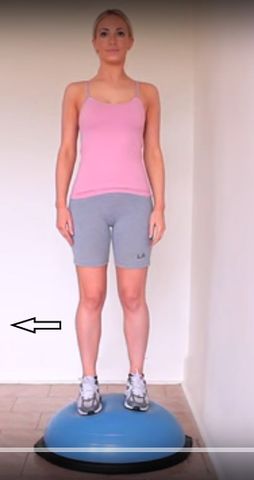
|
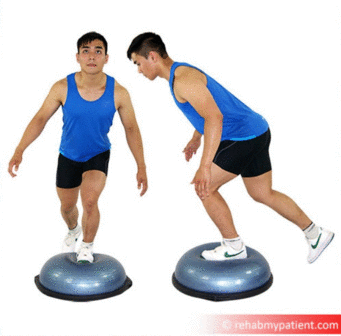
|
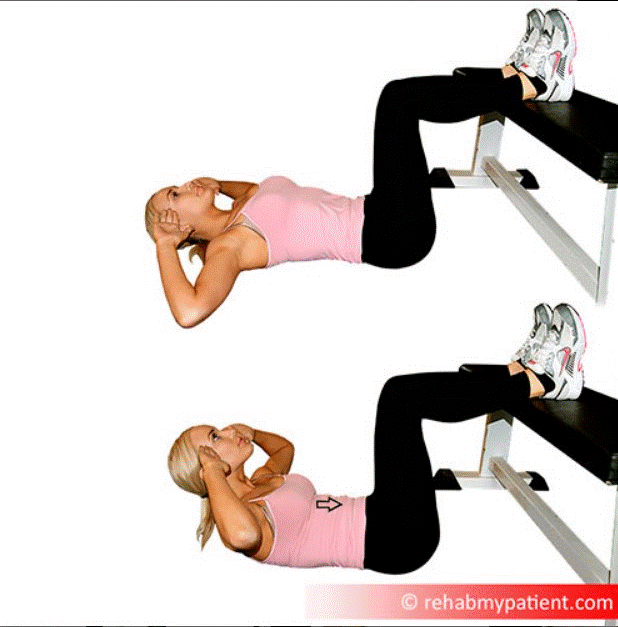
|
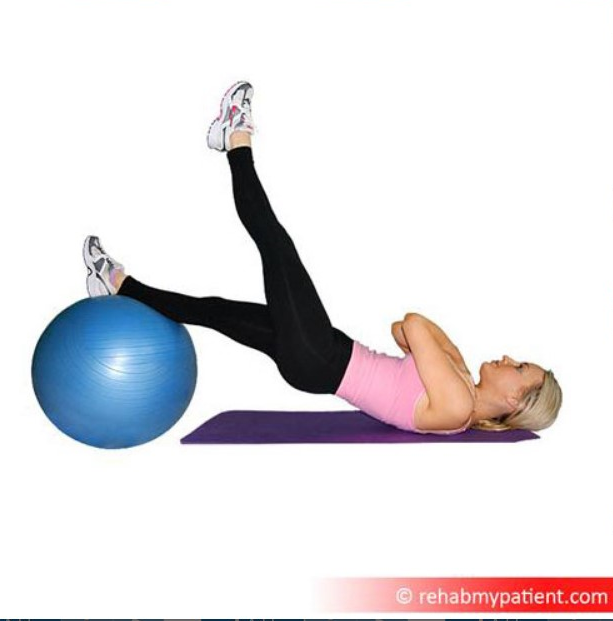
|
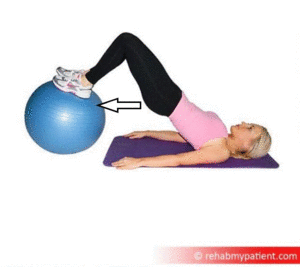
|
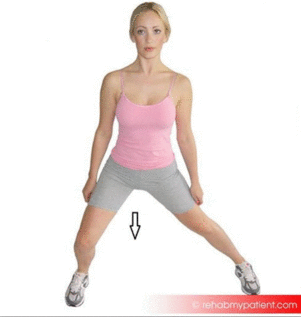
|
Stage III: Power development[edit | edit source]
At this stage, power production of the lower extremity is the main aim. Additionally, athletes are trained to resist fatigue and perform plyometrics with good biomechanics[24]. Training incorporates mid-level intensity double-limb multi-planar plyometric jumps and low-intensity single-limb hops.
Provide feedback and educate the athlete to land softly with coronal plane knee control.
Combining plyometrics with strength training improved jump performance and leg strength[29]. The addition of neuromuscular training with plyometrics, CORE and speed training resulted in great outcomes in performance measures[24].
Examples of exercises to be used in this stage:
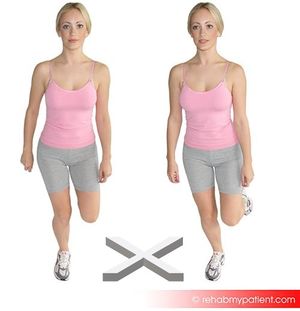
|
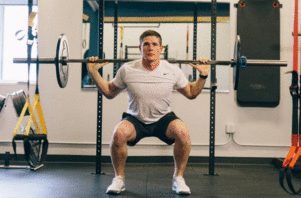
|
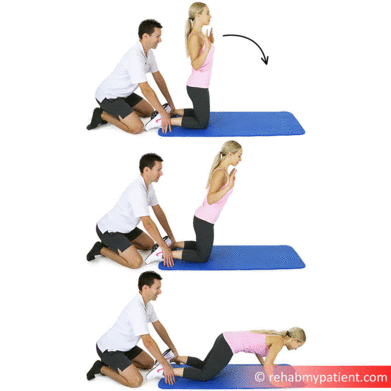
|
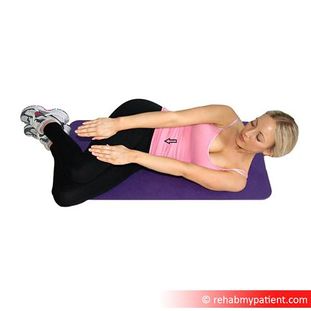
|
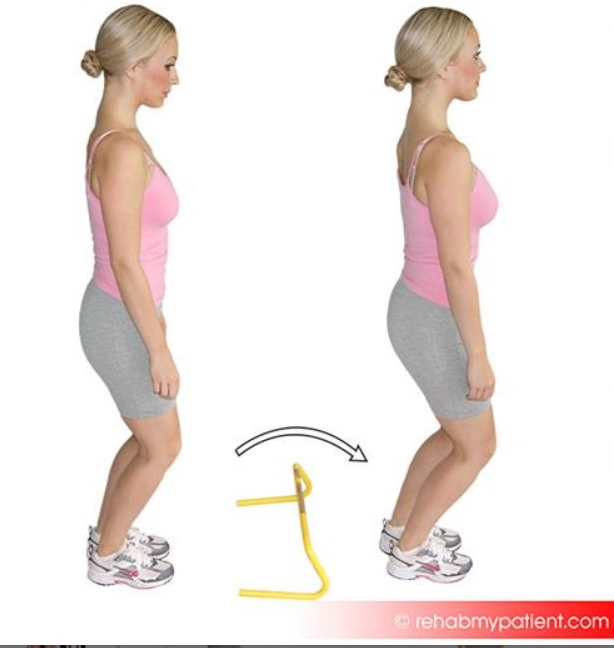
|
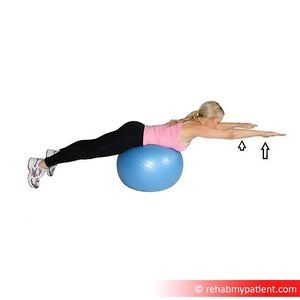
|
Stage IV: Sport Performance Symmetry[edit | edit source]
At this stage, athletes are trained to utilize safe biomechanics (increased knee flexion and decreased knee abduction angles with symmetrical forces and motions between limbs) in high-intensity plyometric exercises, produce symmetrical power between both lower extremities and learn to improve confidence to maintain dynamic knee stability with high-intensity change of direction activities[24].
Verbal and visual feedback are important at this stage.
Increased valgus angle is a factor contributing to injuries, particularly in females. Valgus loads on the knee can double during unanticipated cutting manoeuvres. By teaching athletes to use movement techniques that produce low knee abduction moments during movements that can produce high loads on the joint, they can ultimately reduce the risk of injury[24].
Examples of exercises to be used in this stage:
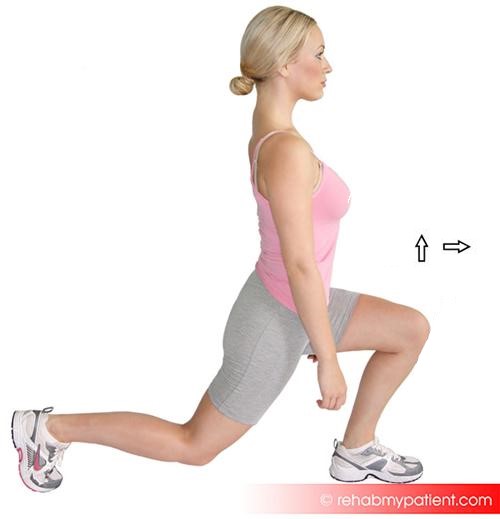
|
[30] |
| [31] | [32] |
| [33] | [34] |
Return to Sport Criteria[edit | edit source]
Evidence of deficits in muscular strength and balance exist months after surgery in both ACL-reconstructed knee and contralateral limb[35]. Abnormal knee kinematics was found up to a year following surgery[36].
A systematic review by Barber-Westin and colleagues[35] investigated return to sport criteria in many studies and concluded that in order to give clearance to return to sport an athlete must have:
- Less than 10% deficit in strength of the quadriceps and hamstring on isokinetic testing at 180°/s and 300°/s,
- Less than 15% deficit in lower limb symmetry on single-leg hop testing (single hop, triple hop, crossover hop, and timed hop)[20]
- Less than 3 mm of increased anterior-posterior tibial displacement on Lachman or knee arthrometer testing,
- Greater than 60% normalized knee separation distance on a video drop-jump test,
- Absence of effusion
- Full knee ROM
- Normal patellar mobility,
- No or only slight patellar crepitus,
- Painless activities without swelling.
| [37] | [38] |
The International Knee Documentation Committee is a great tool to assess knee function and differentiate high knee function from low knee function[22].
Single-legged hop tests assess different measures such as performance, strength, neuromuscular control, confidence in the limb, and the ability to tolerate loads related to sports-specific activities. Specific deficits can be detected in these tests, allowing the clinician to tackle them in the rehabilitation plan and also give an idea on time to return to sport[22].
References[edit | edit source]
- ↑ Dunn WR, Spindler KP, Moon Consortium. Predictors of Activity Level 2 Years After Anterior Cruciate Ligament Reconstruction (ACLR) A Multicenter Orthopaedic Outcomes Network (MOON) ACLR Cohort Study. The American journal of sports medicine 2010;38(10):2040-50.
- ↑ 2.0 2.1 Paterno MV, Rauh MJ, Schmitt LC, Ford KR, Hewett TE. Incidence of second ACL injuries 2 years after primary ACL reconstruction and return to sport. The American journal of sports medicine 2014;42(7):1567-73.
- ↑ Salmon L, Russell V, Musgrove T, Pinczewski L, Refshauge K. Incidence and risk factors for graft rupture and contralateral rupture after anterior cruciate ligament reconstruction. Arthroscopy: The Journal of Arthroscopic & Related Surgery 2005;21(8):948-57.
- ↑ Hurley ET, Mojica ES, Haskel JD, Mannino BJ, Alaia M, Strauss EJ, Jazrawi LM, Gonzlaez-Lomas G. Return to play testing following anterior cruciate reconstruction–A systematic review & meta-analysis. The Knee. 2022 Jan 1;34:134-40.
- ↑ 5.0 5.1 5.2 5.3 Hewett TE1, Myer GD, Ford KR, Heidt RS Jr, Colosimo AJ, McLean SG, van den Bogert AJ, Paterno MV, Succop P. Biomechanical measures of neuromuscular control and valgus loading of the knee predict anterior cruciate ligament injury risk in female athletes: a prospective study. The American journal of sports medicine 2005;33(4):492-501.
- ↑ Zazulak BT, Hewett TE, Reeves NP, Goldberg B, Cholewicki J. Deficits in neuromuscular control of the trunk predict knee injury risk: prospective biomechanical-epidemiologic study. The American journal of sports medicine. 2007;35(7):1123-30.
- ↑ 7.0 7.1 7.2 7.3 7.4 7.5 Hewett TE, Di Stasi SL, Myer GD. Current concepts for injury prevention in athletes after anterior cruciate ligament reconstruction. The American journal of sports medicine 2013;41(1):216-24.
- ↑ Castanharo R, Da Luz BS, Bitar AC, D’Elia CO, Castropil W, Duarte M. Males still have limb asymmetries in multijoint movement tasks more than 2 years following anterior cruciate ligament reconstruction. Journal of Orthopaedic Science 2011;16(5):531.
- ↑ 9.0 9.1 Gupta R, Singhal A, Malhotra A, Soni A, Masih GD, Raghav M. Predictors for Anterior Cruciate Ligament (ACL) Re-injury after Successful Primary ACL Reconstruction (ACLR). Malaysian Orthopaedic Journal. 2020 Nov;14(3):50.
- ↑ 10.0 10.1 Paterno MV, Schmitt LC, Ford KR, Rauh MJ, Myer GD, Huang B, Hewett TE. Biomechanical measures during landing and postural stability predict second anterior cruciate ligament injury after anterior cruciate ligament reconstruction and return to sport. The American journal of sports medicine 2010;38(10):1968-78.
- ↑ Leys T, Salmon L, Waller A, Linklater J, Pinczewski L. Clinical results and risk factors for reinjury 15 years after anterior cruciate ligament reconstruction: a prospective study of hamstring and patellar tendon grafts. The American journal of sports medicine 2012;40(3):595-605.
- ↑ Shelbourne KD, Gray T, Haro M. Incidence of subsequent injury to either knee within 5 years after anterior cruciate ligament reconstruction with patellar tendon autograft. The American journal of sports medicine 2009;37(2):246-51.
- ↑ Battaglia MJ, Cordasco FA, Hannafin JA, Rodeo SA, O'brien SJ, Altchek DW, Cavanaugh J, Wickiewicz TL, Warren RF. Results of revision anterior cruciate ligament surgery. The American journal of sports medicine 2007;35(12):2057-66.
- ↑ 14.0 14.1 14.2 Grindem H, Snyder-Mackler L, Moksnes H, Engebretsen L, Risberg MA. Simple decision rules can reduce reinjury risk by 84% after ACL reconstruction: the Delaware-Oslo ACL cohort study. Br J Sports Med 2016;50(13):804-8.
- ↑ Nagelli CV, Hewett TE. Should return to sport be delayed until 2 years after anterior cruciate ligament reconstruction? Biological and functional considerations. Sports Medicine. 2017 Feb;47(2):221-32.
- ↑ Liew BX, Feller JA, Webster KE. Understanding the psychological mechanisms of return to sports readiness after anterior cruciate ligament reconstruction. PLoS One. 2022 Mar 24;17(3):e0266029.
- ↑ Lentz TA, Zeppieri Jr G, George SZ, Tillman SM, Moser MW, Farmer KW, Chmielewski TL. Comparison of physical impairment, functional, and psychosocial measures based on fear of reinjury/lack of confidence and return-to-sport status after ACL reconstruction. The American journal of sports medicine 2015;43(2):345-53.
- ↑ Everhart JS, Best TM, Flanigan DC. Psychological predictors of anterior cruciate ligament reconstruction outcomes: a systematic review. Knee Surgery, Sports Traumatology, Arthroscopy 2015;23(3):752-62.
- ↑ Culvenor AG, Barton CJ. ACL injuries: the secret probably lies in optimising rehabilitation. Br J Sports Med 2018;52(22):1416-1418.
- ↑ 20.0 20.1 Ebert JR, Edwards P, Du Preez L, Furzer B, Joss B. Knee extensor strength, hop performance, patient-reported outcome and inter-test correlation in patients 9–12 months after anterior cruciate ligament reconstruction. The Knee. 2021 Jun 1;30:176-84.
- ↑ Hannon JP, Wang-Price S, Goto S, Singleton S, Dietrich L, Bothwell J, Bush C, Garrison C. Twelve-week quadriceps strength as a predictor of quadriceps strength at time of return to sport testing following bone-patellar tendon-bone autograft anterior cruciate ligament reconstruction. International Journal of Sports Physical Therapy. 2021;16(3):681.
- ↑ 22.0 22.1 22.2 Logerstedt D, Grindem H, Lynch A, Eitzen I, Engebretsen L, Risberg MA, Axe MJ, Snyder-Mackler L. Single-legged hop tests as predictors of self-reported knee function after anterior cruciate ligament reconstruction: the Delaware-Oslo ACL cohort study. The American journal of sports medicine 2012;40(10):2348-56.
- ↑ Lentz TA, Zeppieri Jr G, Tillman SM, Indelicato PA, Moser MW, George SZ, Chmielewski TL. Return to preinjury sports participation following anterior cruciate ligament reconstruction: contributions of demographic, knee impairment, and self-report measures. Journal of orthopaedic & sports physical therapy 2012;42(11):893-901.
- ↑ 24.0 24.1 24.2 24.3 24.4 24.5 24.6 24.7 Myer GD, Paterno MV, Ford KR, Hewett TE. Neuromuscular training techniques to target deficits before return to sport after anterior cruciate ligament reconstruction. The Journal of Strength & Conditioning Research 2008;22(3):987-1014.
- ↑ Padua DA, Marshall SW, Beutler AI, DeMaio M, Boden BP, Yu B, Garrett WE. Predictors of knee valgus angle during a jump-landing task. Medicine & Science in Sports & Exercise 2005;37(5):S398.
- ↑ van Melick N, van Cingel RE, Brooijmans F, Neeter C, van Tienen T, Hullegie W, Nijhuis-van der Sanden MW. Evidence-based clinical practice update: practice guidelines for anterior cruciate ligament rehabilitation based on a systematic review and multidisciplinary consensus. British journal of sports medicine. 2016 Dec 1;50(24):1506-15.
- ↑ Flynn TW, Soutas-Little RW. Mechanical power and muscle action during forward and backward running. Journal of Orthopaedic & Sports Physical Therapy 1993;17(2):108-12.
- ↑ Flynn TW, Soutas-Little RW. Patellofemoral joint compressive forces in forward and backward running. Journal of Orthopaedic & Sports Physical Therapy 1995;21(5):277-82.
- ↑ Fatouros IG, Jamurtas AZ, Leontsini D, Taxildaris K, Aggelousis N, Kostopoulos N, Buckenmeyer P. Evaluation of plyometric exercise training, weight training, and their combination on vertical jumping performance and leg strength. The Journal of Strength & Conditioning Research 2000;14(4):470-6.
- ↑ Tuck Jump. Available from: https://www.youtube.com/watch?v=zh1v8jINBZ0
- ↑ TFW Explosive Box Step Up. Available from:https://www.youtube.com/watch?v=KDwzB6xuZ9o
- ↑ Depth jump to box jump - Increase vertical jump - Volleyball. Available from: https://www.youtube.com/watch?v=5EztcmA0Amc
- ↑ Four Corner Drill. Available from: https://www.youtube.com/watch?v=HwPCpzLmSYQ
- ↑ SPEED TRAINING: Quick Cut "W" Drill. Available from: https://www.youtube.com/watch?v=hXNuP6ohxwQ
- ↑ 35.0 35.1 Barber-Westin SD, Noyes FR. Factors used to determine return to unrestricted sports activities after anterior cruciate ligament reconstruction. Arthroscopy: The Journal of Arthroscopic & Related Surgery 2011;27(12):1697-705.
- ↑ Deneweth JM, Bey MJ, McLean SG, Lock TR, Kolowich PA, Tashman S. Tibiofemoral joint kinematics of the anterior cruciate ligament-reconstructed knee during a single-legged hop landing. The American journal of sports medicine 2010;38(9):1820-8.
- ↑ ACL Prevention Screening: The Drop Jump Test. Available from:https://www.youtube.com/watch?v=5DrD-G4gWt8
- ↑ Triple hop for distance. Available from: https://www.youtube.com/watch?v=4Rp_BJUBQ6g






